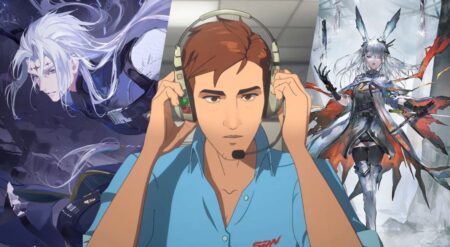
CONTENT WARNING: This article contains spoilers for Guillermo del Toro’s Nightmare Alley and its ending.
“No man can outrun God.” Those prophetic words are spoken to Bradley Cooper’s Stanton Carlisle during the first act of Guillermo del Toro’s neo-noir Nightmare Alley, and the end of the movie sees fate sink its jaws into him. Carlisle’s ambition winds cost him the love of his wife Molly (Rooney Mara), his sanity after entering into an affair with manipulative psychiatrist Lilith Ritter (Cate Blanchett), and even his freedom after he tries to swindle the wealthy Ezra Grindle (Richard Jenkins). I was utterly captivated and devastated by Nightmare Alley, as it marks a major departure from del Toro’s previous films, especially in one area: the ending.
Guillermo del Toro has become known for more than a few hallmarks in his filmography: bizarre creatures who are often more human than the actual humans in the film, immaculately constructed production design, and the presence of Ron Perlman. Yet, a recurring element that not many people have picked up on is the concept of fate. Like Stanton, many of these characters are on a collision course with what seems to be an irrevocable fate. Through sheer force of will and a little ingenuity, each character manages to “outrun God” in their own way.
Take Hellboy, for example. Guillermo del Toro’s adaptation of the Dark Horse Comics hero hews fairly close to his origin; Hellboy was summoned to Earth by the Russian sorcerer Grigori Rasputin and Nazi occultists who intended to unleash the Ogdru Jahad — the Dragon in the Book of Revelation. Hellboy is fated to use his Right Hand of Doom — the massive stone appendage attached to his right arm — to unleash the Jahad upon the Earth and bring endless destruction. Yet, he chooses to defy his fate, especially as his adoptive father, Trevor Bruttenholm, has raised him with a strong sense of morals. Hellboy later serves as an agent of the Bureau for Paranormal Research and Defense (B.P.R.D.), fighting monsters and threats to the world, including Rasputin in the first film and the elven prince Nuada in its sequel, The Golden Army.
Pacific Rim is another example, as it features humanity banding together to battle the impossible. Massive creatures known as Kaiju are emerging from an interdimensional rift in the Pacific Ocean, and to combat them, the world built massive war machines known as Jaegers. However, humanity’s days seem numbered as bigger Kaiju come to our world with biological enhancements that allow them to counter and destroy the Jaegers. Still, Marshal Stacker Pentecost (Idris Elba), the leader of the Pan-Pacific Defense Corps, refuses to give up. Pentecost is determined to end the threat of the Kaiju by taking a nuke to the portal and crossing over to the other universe to destroy the Kaiju’s Progenitors. Leading up to that moment, Elba gives one of the best speeches I’ve heard in a film, which I have to repost in its entirety:
“Today, today… at the edge of our hope, at the end of our time, we’ve chosen not only to believe in ourselves but in each other. Today, there’s not a man nor woman in here that shall stand alone. Not today. Today we face the monsters that are at our door and bring the fight to them! Today, we are canceling the apocalypse!”
Finally, we come to the Tales of Arcadia saga and its grand finale Trollhunters: Rise of the Titans, which Guillermo del Toro helped develop based on the young adult novel he co-wrote with Daniel Kraus. The film features Trollhunter Jim Lake Jr. (Emilie Hirsch) and his various allies fighting to stop the malevolent Arcane Order from wiping out all of humanity with their massive Titans. In the end, they are victorious — but many have fallen in battle, including Jim’s best friend Toby (Charlie Saxton). Jim uses a device known as the Kronisphere to alter time so that Toby lives and even directs him to where the Trollhunter amulet is. In giving Toby a second chance at life, Jim alters not only his friend’s fate but potentially the fate of the friends he lost in the original timeline. While Rise of the Titans has gained controversy from the Trollhunters fanbase due to its ending, I ultimately think it’s a hopeful one as Jim has a chance to do things differently.
Nightmare Alley ‘s ending differs from these films due to its fatalistic streak. Stan eventually does meet a grim and darkly ironic fate albeit in a poetic fashion. In the film’s opening, he goes to a carnival and attends the “geek show,” which features a strung out, barely coherent man biting the head off a chicken. When talking with carnival barker Clem (Willem Dafoe), Stan learns that the “geek show” is for men who’ve been run down by life. The barker at a carnival will usually reel them in with the offer of a “temporary” job and break them in with verbal abuse and drugs added to their alcohol. In the final scene of the film, a destitute and run-down Stan attempts to offer his services, and the barker tells him he has a “temporary” job for him-bringing his journey full circle. In the end, he couldn’t outrun God.
Nightmare Alley is now playing in theaters.






